Ève Chabanon: The Surplus of the non-producer
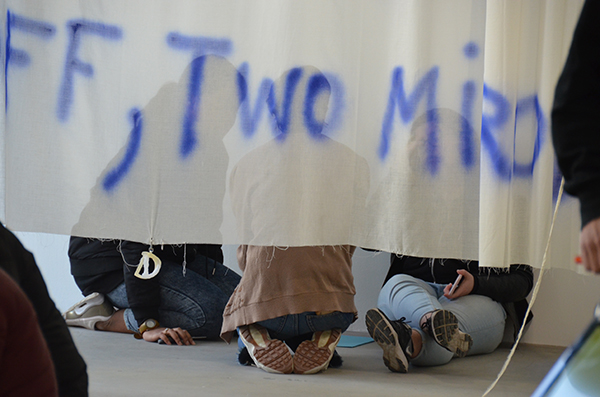
The Surplus of the non-producer is a film at the crossroads between documentary, performance and fiction. It takes as a starting point the difficulty or even the inability of the craftsman, artist or cultural practitioner in exile, to exercise their practice in the face of various obstacles: technical on the one hand (the linguistic barrier implying the impossibility of explaining a profession sometimes unknown in France, or presenting diplomas) or purely legal on the other hand (related to labor rights and the impossibility of presenting documents).
The project was born in March 2017, in collaboration with Lafayette Anticipations, Thot, La Fabrique Nomade, the agency of artists in exile, Mode Estime and Du Pain et des Roses.
–
In economics, the "producer surplus" refers to the difference between the price at which a producer is willing to sell a good and its market price. In the writing of the film, the "non-producers" represent both the film crew and the subject. Bringing together high-school students and practitioners faced with the inability of their practices, The Surplus of the non-producer becomes a meeting point between people whose voices are barely heard or not heard at all. From this collaboration is born a "surplus" that resonates as an act of resistance.
During five sessions, the high-school was transformed into a film set with a cinematographer, a cameraman and a sound engineer. For each session, Ève Chabanon invited a person in exile to present their background and conduct a workshop directly related to their practice.
++++
WITH THE PARTICIPATION OF :
Martine Orlue (11th grade French teacher), Lauriane Jumel (10th grade French teacher), Céline Delatouche (10th grade English teacher) and Flora Ramires (11th grade Spanish teacher).
FILM CREW :
Michele Gurrieri (operator), Pierre Bompy (sound engineer), Matthieu Deluc (cameraman)
PRODUCTION:
Misia Movie
Many thanks to Violetta Kreimer
COORDINATION OF THE PROJECT:
Mathilde Assier, Fanny Spano
SESSION 1: MONDAY, DECEMBER 17, 2018
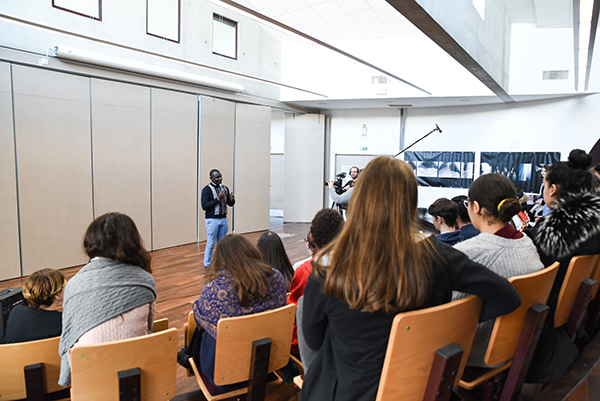
Ève Chabanon, Olivier Iturerere
To begin this series of meetings with Olivier Iturerere, a political refugee from Burundi and a film producer, questions the difficulty of creating in the context of a political crisis. The discussion between the two classes of the Julie Victoire-Daubié Highschool - two 10th and 11th grade classes - and Olivier around his story made it possible to embody a faraway reality for the high school students.
The producer was repressed and censored for his documentary work aimed at reporting on a violent and authoritarian state. Under these conditions, how can one exercise one’s profession and continue to document a truth that cannot be silenced?

Olivier’s workshop with the students was a way of answering this question by inviting them to make a portrait of one of their classmates without seeing their face. Responding to the fantasy of the film set, the portrait-image, the description, is created through narration by filming a detail: hair in hand, the bodies of the teenagers became clues, bits of stories piling up.
+++
Olivier Iturerere, production director
Olivier Iturerere was born in Burundi in 1988. After his studies in telecommunications and computer science, he created a production company (ITULIVE Media & Communications). In 2013, he directed his first documentary film, Kilo 8, which received the Grand Jury Prize at the 7th edition of the Festival Cinéma et Droits de l’Homme organized in 2017 by Amnesty International Paris, and which was selected in 2017 at the Masuku Festival (Gabon). He notably produced The Springboard, a feature-length documentary by Joseph Ndayisenga broadcasted on TV5 Monde, which won the prize for best documentary at the International Festival of Cinema and Audiovisual of Burundi (FESTICAB) in 2015. In 2016, he participated in a writing residency at the FEMIS in Paris. Today, he is called the First Young Burundian Producer and directs Let’s Make Movies, a project destined to train young film enthusiasts in writing and directing short films in Burundi with Umugani Group and Itulive Pictures.
SESSION 2: MONDAY, JANUARY 14, 2019
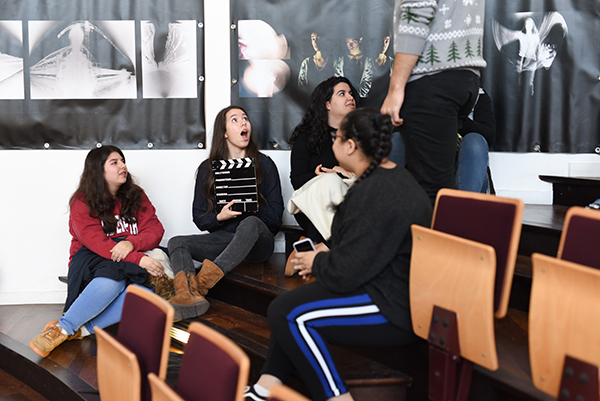
Ève Chabanon, Abdulmajeed Haydar
When retracing his career as a screenwriter in Syria, Abdulmajeed Haydar explains that he has always been a "liar", his practice oscillating between the imaginary and the real. How, then, do you tell stories? Who can take responsibility for them when they become the truth in order to make history? Writing as a screenwriter in Syria is eminently a political act, especially when the discourse does not match the expectations of a repressive government.
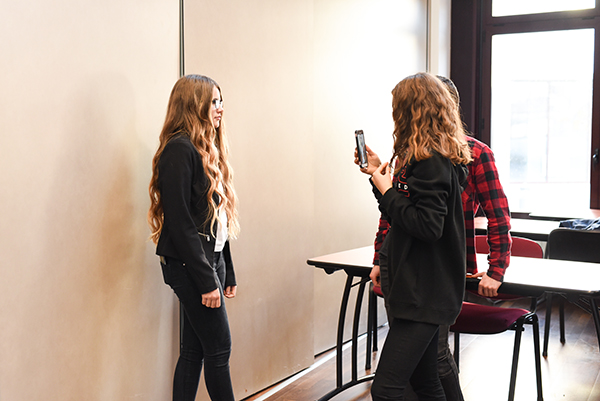
During the workshop with the students, Abdulmajeed Haydar started from the observation that writing can be a stimulating process in a context of perpetual war and censorship, becoming a system of stratagems to divert authority and repression.
+++
Abdulmajeed Haydar, screenwriter
Abdulmajeed Haydar was born in 1960 in Damascus. Palestinian from Syria, he is a scriptwriter for several series on Syrian television, feature films and short films. As early as 1987, he organized a literary and cinematographic evening in a Palestinian camp in Syria but was soon subject to reprisals, because he was considered anti-regime. Abdulmajeed’s series are based on Interactive Drama (in which the audience is called in by telephone to choose an ending to the story), and were soon censored by the intelligence services, which detected information against the state, and blacklisted them. In 2014, he participated in Liwaa Yazji’s documentary film Haunted. He is perpetually inclined to write new series.
SESSION 3: MONDAY, JANUARY 21, 2019
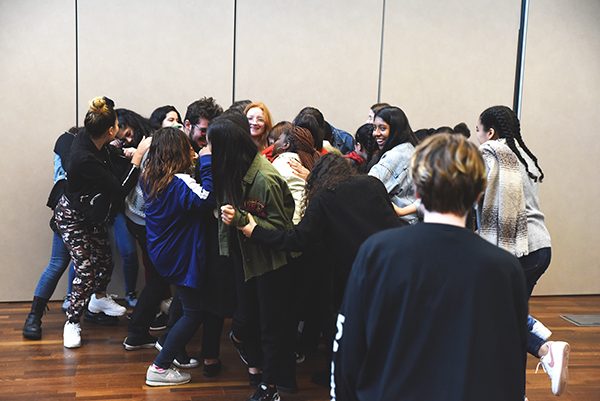
Ève Chabanon, Aram Ikram Tastekin
Aram Ikram Tastekin studied theatre in Kurdistan, a country split up in the south-east of Turkey, located on the border with Iraq, Iran and Syria.
For the Kurdish comedian and documentary filmmaker Aram Ikram Tastekin, the relationship with school is linked to identity. The school was the place where he heard his first name for the first time, and which enabled him to obtain his diplomatic visa in order to continue his theatre studies in France. Except that the identity of the Kurdish people is not recognized in Turkey; and when in 2015 the peace between the Turkish authorities and Kurdish rebels was broken, the repression against Kurdish opponents, intellectuals and artists increased; and he was brutally dismissed from his position as a theatre teacher, making him an outcast.
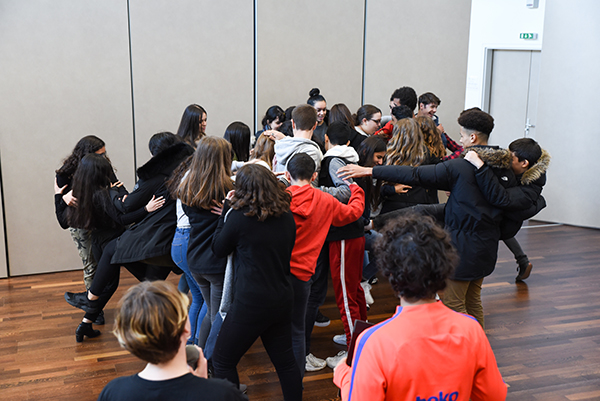
Faced with the Turkish regime imposing fierce censorship, Aram raises the question of distribution: how to express oneself freely under the yoke of the discrimination of the discourse? For the actor speaking Kurdish, Turkish, English, Russian and French, language and culture cannot be set up as barriers. His workshops of theatrical improvisation in eight gestures - in reference to the eight kilometers round trip between the school and the village of his childhood - or dialogues in a fictional language, that are supposed to be improvised, revealed the high school students how the body, beyond language, participates in the construction of the identity, of trust and acceptance of the other.
+++
Aram Ikram Tastekin, actor
Aram Ikram Tastekin is an actor, documentary filmmaker and activist. Trained at the conservatory, he is a local figure in the predominantly Kurdish city of Diyarbakir, where he taught drama at a Kurdish community center. In 2015, he filmed clashes between the Turkish army and militants of the Kurdistan Workers’ Party, the PKK. This earned him an initial arrest, then, after the documentary was broadcasted, he became the subject of an investigation for "terrorist propaganda”. Shortly before the outcome of the trial, he flew to France, where he took part in the production of a Kurdish music festival. He worked on his project of a musical comedy in Kurdish, in anticipation of a possible return to Diyarbakir.
SESSION 4 : MONDAY, JANUARY 28, 2019

Ève Chabanon, Nassima Shavaeva
To silence and erase a culture to protect oneself, and in the end taking it over and reviving it to fight against oblivion. Nassima is a singer and dancer of Uyghur origin, one of the Turkish-speaking Muslim ethnic minorities living in Central Asia. On the border of Kazakhstan and Uzbekistan, the Xinjiang region of China has developed into a totalitarian police state, where arbitrary detentions target and condemn all Uyghur cultural expressions, down to religious and linguistic traditions.
In the face of bitterly repressed speech and mobility, singing and dancing became a space of freedom. Gathering words to tell her story and describe her culture to high school students proved to be all the more demanding since she had never been allowed to do so. She, who for a long time did not dare to sing, suffocated by the yoke of police muzzling, restored Uyghur culture to the students, inviting them to sing with her. From this resilience born of a repressed inner rhythm, Nassima revealed how singing, like dancing, can open up spaces of freedom, resistance and dialogue. She wears traditional dresses for certain scenes.
+++
Nassima Shavaeva, singer and dancer
Nassima Shavaeva grew up in a family of musicians. She remembers dancing and singing from the age of five. Of Uyghur culture, she is originally from Kazakhstan and Uzbekistan, and usually performs with her husband Azamat Abdurakhmanov. The couple performs in Kazakhstan in numerous performances at the Uyghur National Theatre in Almaty, in concerts and TV shows. They signed a duo record: Iaïra. Nassima Shavaeva has been living in France since 2016 and since then they have been trying to reconstruct their repertoire while making it evolve, notably by teaming up with different musicians such as Elie Maalouf or Wael Alkak.
SESSION 5: MONDAY, FEBRUARY 4, 2019
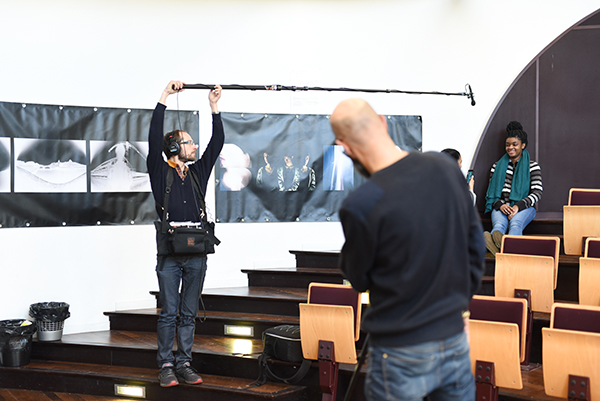
Ève Chabanon, Yara Al Najem
Is it possible to evoke war in a non-violent way without obscuring its gravity? Graphic designer and illustrator, Yara Al Najem, belongs to the Syrian youth who overthrew a dictatorial and security-focused state apparatus in place since 1963.
When in 2011, the Syrian population was granted the right to access websites such as Youtube and Facebook, Yara entered college. Faced with high school students born with an Internet of free entertainment, Yara opposed a virtual network as a tool for communication and dissemination of a crisis situation. While in our western societies Facebook appears as a narcissistic tool of community partitioning, for the Syrian youth and Yara, it was a space of dialogue and recreation. In a country where freedom of the press is asphyxiated and non-existent, Yara came to support the extent to which her work as a press illustrator, beyond the informative part, is understood as a vector of joy and hope against the cruelty and tyranny of a derisory government. She thus evoked the elaboration of a children’s booklet designed as a playful instruction manual to avoid bombs, accompanied by a few games. Playing on the paradox of the real world and the vocabulary of graphic design, that was the challenge of her poster workshop, thereby questioning the simple impact of a typography.
+++
Yara Al Najem, graphic designer
Yara Al Najem was born in 1990 in Al-Sweida, Syria. Originally from Damascus, she graduated from the Damascus University / Fine Arts Faculty in Visual Communication in 2012, while engaging in various student events. She participates in many exhibitions, including "Al Carama Ela Ayn" in Jordan in 2012, "Aswat Sorya" in Switzerland in 2013, and Imago Mundi in Italy in 2015. She worked as a graphic designer for InCoStrat, from 2013 to 2016, and for Ark Group DMCC, from 2012 to 2013.
OUTING : TUESDAY, MARCH 12, 2019

Ève Chabanon, Bétonsalon Team
After a debriefing session with both classes at the high school, the students were able to get a glimpse of the first few bits of a project that would continue towards Wellington, where Eve was already starting a new residence. As a conclusion to this first stage of the arborescent film project The Surplus of the non-producer, the two classes of the Julie-Victoire Daubié Highschool met up with Ève again for a meeting with Bétonsalon – Center for art and research and its immediate environment : the Paris-Diderot University, and the 13th district. While the art center was presenting the group exhibition Lateral Recovery Position, the students were invited to enter a space where their perceptions and ability to imagine were put to use. In the form of a survey that sharpened their curiosity and critical thinking, the students, through the exhibition, questioned the place of violence and conflict in social and political relations. Taking full possession of the space, and breaking the prism of an abstruse and inaccessible contemporary art, the consideration of the other and of feelings took an unexpected form when they picked up their phones to question the artist Adrian Mabileau, who had left his number on one of his installations.
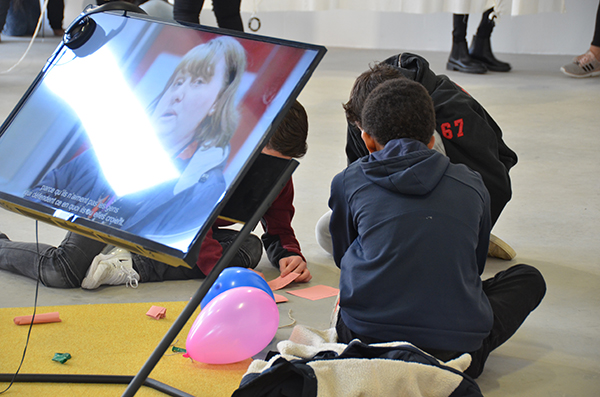
As an introduction to the urban planning and socio-cultural issues of territorial anchorage addressed in the upcoming project conducted with the Bondy Blog, the high school students discovered the 13th arrondissement and the ZAC Paris Rive Gauche during a Street Art stroll that raised awareness of the common heritage of the multiple cultures of the Grand Paris. Faced with the modernity of this science fiction district, the appropriation of the street through art and by artists offered the awareness of the possibility to grasp a historical narrative being written..
A piece of history under free and clear skies, this day made of varied encounters was the culmination of an off-site project, a moment of openness and mutual surpassing, the trampling of borders and prejudices, that act as brakes to thought and creativity.
Share